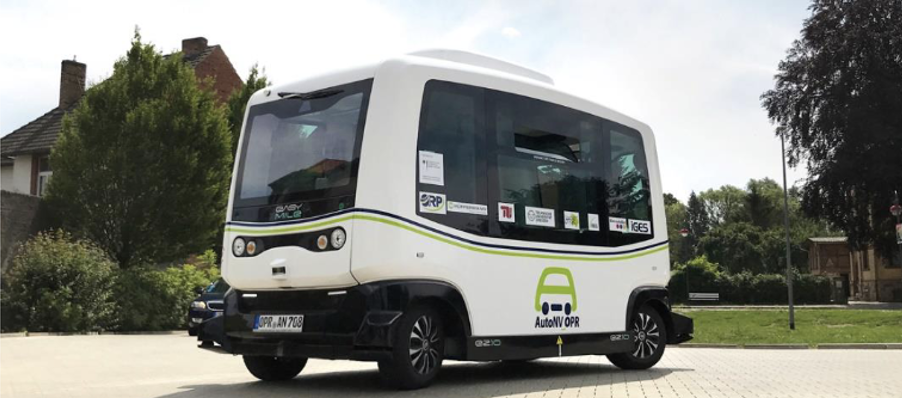From July 2019 to March 2020, a trial operation of an autonomous bus shuttle in the rural region Ostprignitz-Ruppin in Germany was scientifically accompanied by the Chair of Traffic and Transportation Psychology at TU Dresden – a SINFONICA project partner. The focus was put on evaluating user acceptance in a pre/ post-design to identify and reduce barriers to such a public transport service.
The tested autonomous bus shuttle (in the video above) by Easymile EZ10 Gen2 served on a total of three different route lengths, whereby the original route (600 m) was gradually extended by two stages (3,5 km and 8 km). Operating hours were on workdays from 9 am to 6 pm. The shuttle rides were free of charge for passengers. During the rides, an operator still had to take manual control of the vehicle relatively frequently during regular service to master certain traffic situations, such as the right-of-way situation “right before left”. The shuttle was restricted to a maximum speed of 15 km/h and operated solely according to the timetable in regular service with fixed stops.

—
Autonomous shuttle bus tested in the rural region Ostprignitz-Ruppin (2)
Before the test pilot started, a survey was sent to the residents of the test site Wusterhausen/Dosse via postal mail. The aim was to study the attitudes and intentions of potential users to use the autonomous bus shuttle even before they had experienced the service. This survey resulted in a total of 456 responses. After the bus shuttle had been in service for nine months, a second survey was conducted, asking for the same assessments but additionally including questions referring to the actual usage behavior. This approach allowed looking into the influence of the initial acceptance, attitudes, and intentions on adopting the new service. A total of 194 residents volunteered to participate again in the survey. In addition, 151 face-to-face passenger surveys were conducted during the nine-month pilot test operation, asking for users’ impressions, e.g., possible improvements, directly while on the shuttle.
Results showed that the autonomous bus shuttle was used by 47% of the residents, the majority of whom were 60+ years of age. The survey participants generally expect an improvement in mobility services in rural areas and older people’s mobility situation (94% of respondents). During the pilot phase, a significant drop in safety concerns was observed, which might also be partly due to the slow operating speed. The perceived ease of use, an essential factor influencing acceptance, was assessed as high during the pilot phase. Due to the experiences of the bus’s low maximum speed and the fixed timetable, the use for everyday mobility was rated low by the residents. Subsequently, the shuttle bus was seen as less valuable at the project end than before the test pilot.
Nevertheless, the attitudes towards autonomous shuttle buses remained high, showing potential users’ openness towards such a service even before experiencing it. Around 75% of the respondents showed a positive attitude towards autonomous shuttle buses. Unsurprisingly, later non-users differed already in their before-acceptance and attitude measures from later users, likely contributing to the non-adoption of the service during the pilot phase. Results from the face-to-face passenger surveys showed that most passengers got on board out of curiosity and interest in the new technology. Safety, reliability, and comfort were generally rated high, but a need for improvement was seen concerning barrier-free design. For example, the lack of space for walking frames and wheelchairs and an entrance height that was too high were criticized.
In summary, the project showed that autonomous shuttle bus pilots could contribute to reducing concerns about this new public transport service. Especially in rural areas, a potential is seen in fulfilling older peoples’ mobility needs, not least because older users showed as high acceptance levels as younger reference persons. At the same time, the existing shuttle buses, with their technological and legal limits, currently (at least at the time of the test pilot in 2019/2020) seem not yet to meet the requirements to serve the daily mobility needs of people in rural areas.
Authors: Juliane Anke, Madlen Ringhand (TUD)
Aknowledgments
The authors would like to acknowledge the work of Pascal Friebel, responsible research associate of the project from the Chair of Traffic and Transportation Psychology at TU Dresden, and the role of survey participants.
Funding
The research presented in this blog post was funded by the German Federal Ministry for Digital and Transport.
References
[1] Richter, T., Brenck, A., Böckler, L., & Egoldt, A. Autonomer öffentlicher Nahverkehr im ländlichen Raum (Landkreis Ostprignitz-Ruppin), Wirkungsforschung zu neuen Formen innovativer öffentlicher Mobilität und Nutzerakzeptanz anhand eines Probebetriebs in der Modellregion Ostprignitz-Ruppin: Endbericht. Autonomer öffentlicher Nahverkehr im ländlichen Raum (Landkreis Ostprignitz-Ruppin), Wirkungsforschung zu neuen Formen innovativer öffentlicher Mobilität und Nutzerakzeptanz anhand eines Probebetriebs in der Modellregion Ostprignitz-Ruppin. Advance online publication. https://doi.org/10.2314/KXP:1795015837
[2] Picture by www.rosengruen.de


